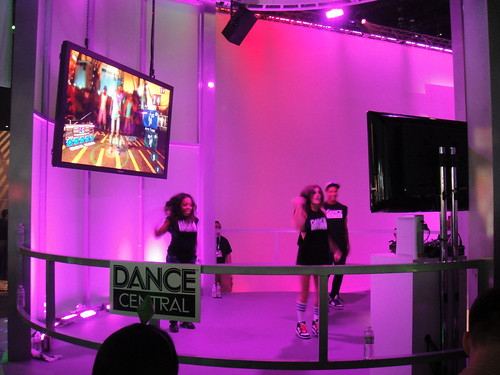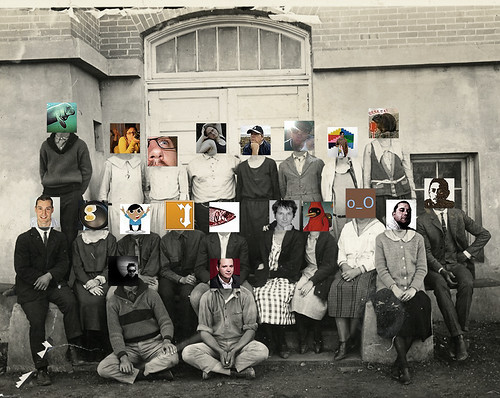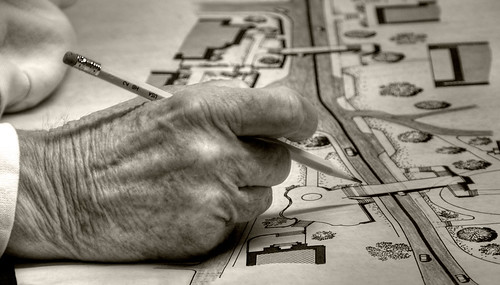
E3 2010 Kinect Dance Central stage by popculturegeek.com
This is what some might call a casual game, "typically distinguished by their simple rules and lack of commitment required in contrast to more complex hardcore games." This is one of my favourite genres because I find it hard to find the time for longer, more involved games (case in point: I started playing Portal months ago and still haven't finished). I also love the social aspect - many games are kind of boring played alone, but are a blast when you have friends over.
This brings me to the main question at hand: Is the Kinect ever going to be used for anything other than casual games?
(My quick answer: I think it's possible if our creativity is up to the task!)
We have a fairly new game development club here at Carleton, and we've been discussing the Kinect for a couple of weeks now. I did a little presentation on augmented reality and how I thought the Kinect could fit in last week, and yesterday I brought in my Xbox and Kinect so we could experience it first hand. Most of those who tried Kinect Adventures seemed to enjoy it - you could almost see the moment they stopped feeling silly and got lost in the game.
There were a couple of guys who refused to try it, though. Their philosophy was that these games were silly, because they tend to be either a repetition of the same movements over and over in slightly varying contexts, as in Kinect Adventures, or mimicry of an activity you may as well just do in real life (like dancing, or tackling the challenge of playing guitar). Why would you want to play a game about dancing when you could just go out dancing with your friends? (I am of the philosophy that games are fun, and that they don't have to replace the real-life versions of these activities - they just provide another way to enjoy them.)
These weren't the only two who didn't see a very interesting future for Kinect, though. In fact I'd say our discussion turned into a somewhat heated (though civil!) debate on the matter. I, with a few others, believed that Kinect could go beyond casual games. We (as in game designers) just aren't necessarily sure how to do it yet.
One person who was not convinced at all explained his stance by pointing out that the Kinect isn't accurate enough to allow for complex game mechanics, and therefore it could never be used for a 'deep' game. I tried to say that while it can't be used for the types of games that need that kind of input precision (like shooters, RTS, etc), that's not what it's meant for. I think we will come up with new types of mechanics that take advantage of the Kinect style of input.
It seemed to me that there was an equating of complex mechanics and inputs with the ability to have a deep game, but I don't think this is the case at all - otherwise, how would you explain the depth found in many board games? Chess and Go, for example, have very simple mechanics but lots of emergent behaviour. I could see myself getting pretty deeply immersed in a game that used some form of Kinect input while engrossing me in a great story. It's possible the result wouldn't please the hardcore gamers, but that's not really a problem from my point of view, since the potential market of 'rest of us' is pretty huge.
An alternative perspective is to consider that a game's inputs don't have to come only from Kinect. For example, a fellow club member suggested having the Kinect get some basic body language information from the player might cause the non-player characters to react appropriately. I figure even voice could be used here, the tone being interpreted as friendly or not. Or customization in a game could come from objects in your playing space or movements you make. A neat idea I had when someone was talking about fighter games was to capture your characters opening pre-fight sequence. Or perhaps the Kinect just gives you a choice - you can either shoot your occasional-use slingshot with the regular controller, or do the aiming with your hands. With so much work going on in the Kinect hacking arena, innovation certainly seems possible.
For a specific example of inspiration, check out the video below. It's not using Kinect, but this kind of input could be done with Kinect and a projector, and perhaps a similar enough game could be created for a traditional screen. The demo shows and open play type of environment, but I could see creating a game that would be considered deep for a younger audience (or even adults if done right).
While I can't say for sure whether we as game designers are ready to come up with ways to use Kinect for deep games (maybe we need to go through another generation or two of technology first), one thing's for sure: this is definitely a hot topic of debate. Where do you stand on it? Where do you see Kinect going in the future?



